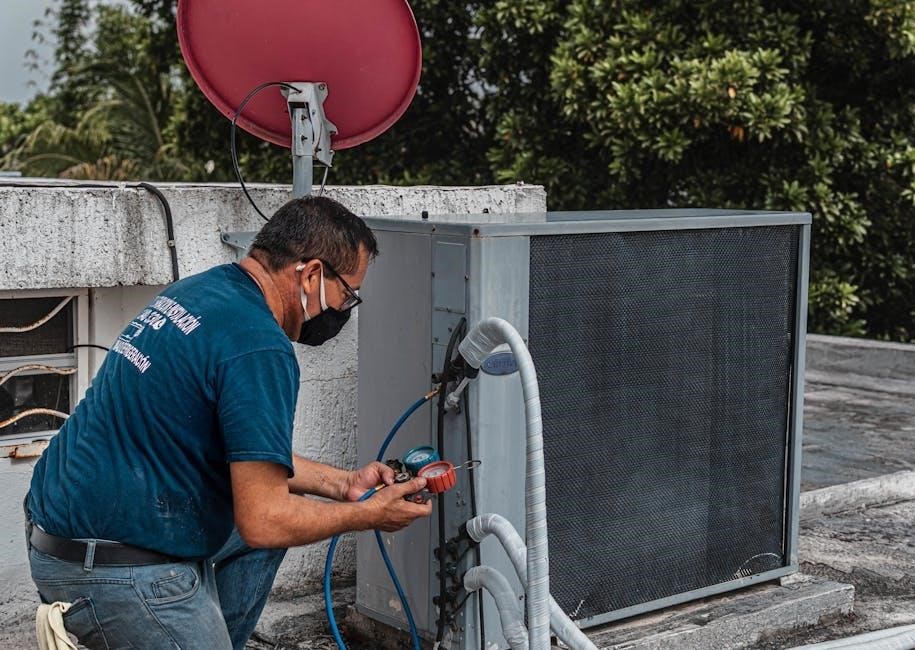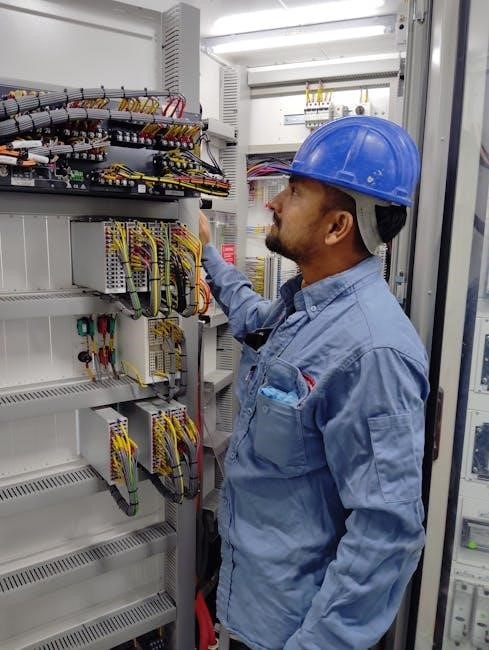This manual provides essential guidance for diagnosing and resolving common issues encountered with Dometic RV air conditioners․ It offers comprehensive troubleshooting steps, maintenance advice, and resources for finding specific documentation․ It’s your handy guide!
Understanding Dometic RV Air Conditioner Systems
Dometic RV air conditioners are integral for maintaining comfort in recreational vehicles, especially during hot weather․ These systems, while similar to household AC units, have unique features and maintenance requirements․ They typically consist of a rooftop unit containing the compressor, condenser, and evaporator coils․ A fan circulates air over these coils, cooling the RV’s interior․
Unlike home units, RV air conditioners are designed to operate on a mobile power system, often using generators or shore power․ Understanding the specific model, its BTU rating, and its electrical requirements is crucial for effective troubleshooting․ Furthermore, knowing the system’s components – such as the thermostat, control box, and capacitors – aids in diagnosing problems․ Regular maintenance, including filter cleaning and coil inspection, is essential for optimal performance and longevity․ Recognizing that RV systems are more susceptible to power surges necessitates preventative measures such as surge protectors․
Common Issues with Dometic RV Air Conditioners
Dometic RV air conditioners, while reliable, can experience a range of common issues․ One frequent problem is the unit failing to turn on, often due to power connection problems, blown fuses, or incorrect thermostat settings․ Another issue is the AC blowing warm air, which can be caused by a refrigerant leak, iced-up coils, or a malfunctioning compressor․
Reduced airflow is also a common complaint, typically resulting from clogged air filters or blocked vents․ Thermostat malfunctions can lead to erratic cooling or heating cycles․ Electrical problems, such as faulty capacitors or relays, can cause the system to fail․ Water leaks inside the RV may indicate a blocked condensate drain․ Finally, control box failures, often triggered by power surges, can disrupt the entire system․ Addressing these issues promptly can prevent further damage and ensure comfortable RV travel․

Troubleshooting Steps
This section outlines a systematic approach to diagnosing and resolving common Dometic RV air conditioner problems․ Follow these steps to identify the issue and implement the appropriate solution efficiently and safely․
Initial Checks: Power and Connections
Begin troubleshooting your Dometic RV air conditioner by confirming a stable power supply․ Inspect the RV’s shore power connection, ensuring it’s securely plugged in and providing the correct voltage․ Check the circuit breakers related to the AC unit in the electrical panel, resetting any tripped breakers․ If using a generator, verify it’s running correctly and delivering consistent power․
Next, examine all electrical connections to the air conditioner․ Look for loose wiring or corroded terminals, tightening or cleaning them as needed․ Pay close attention to the connections at the unit itself and the thermostat․ Ensure all cables are properly seated and undamaged․ A multimeter can be used to test for voltage at key points, confirming power is reaching the unit․
Also, verify that the RV’s battery is adequately charged, as some AC units rely on the battery for certain functions․ Address any power-related issues before proceeding with further troubleshooting steps․
Thermostat Problems and Resetting
Thermostat issues are a common cause of Dometic RV air conditioner malfunctions․ Start by ensuring the thermostat is set correctly to the desired cooling mode and temperature․ Check the thermostat’s display for any error codes or unusual indicators, consulting your Dometic manual for interpretation․
If the thermostat is unresponsive or displaying incorrect information, try resetting it․ Many Dometic thermostats can be reset by switching the mode to “off,” then simultaneously pressing the “mode” and “temp up” buttons until two dashes appear on the screen․ This indicates a successful reset․
Inspect the thermostat’s wiring connections, ensuring they are secure and free from corrosion․ A faulty thermostat can prevent the AC unit from turning on or cycling properly․ If resetting doesn’t resolve the issue, consider replacing the thermostat with a compatible Dometic model․
For multi-zone systems, ensure the correct zone is selected and that the thermostat is communicating with the corresponding AC unit․ Sometimes, communication issues can arise, requiring further investigation․
Airflow Obstructions: Filters and Vents
Restricted airflow is a frequent culprit behind poor Dometic RV air conditioner performance․ The first step is to inspect and clean or replace the air filter․ A dirty filter restricts airflow, forcing the AC unit to work harder and reducing its cooling efficiency․ Regular filter maintenance is crucial․
Locate the air filter, typically found inside the interior unit’s housing․ Remove the filter and clean it with mild soap and water, or replace it with a new filter of the correct size and type․
Next, examine the air vents for any obstructions․ Ensure that furniture, curtains, or other objects are not blocking the vents, as this can significantly reduce airflow․
Check the return air vents as well, as these can also become blocked․ Clear any debris or obstructions to ensure proper air circulation throughout the RV․
Insufficient airflow can lead to the AC unit icing up, further reducing its cooling capacity․ Addressing airflow obstructions is a simple yet effective way to improve your Dometic RV air conditioner’s performance and efficiency․
Condensate Drain Issues
Dometic RV air conditioners produce condensate as they cool, and this water needs to drain properly․ Clogged or malfunctioning condensate drains can lead to water leaks inside your RV, causing damage and promoting mold growth․ Regularly inspecting and maintaining the condensate drain system is therefore essential․
Locate the condensate drain outlet, usually found on the exterior of the RV, near the AC unit․ Check for any obstructions, such as debris, insects, or algae growth․ Use a small wire or pipe cleaner to clear any blockages․
If you’re not seeing puddles under the AC in humid weather, it’s a sign the drains are plugged․ You can also try pouring a small amount of water into the drain pan inside the RV to see if it drains properly․
Ensure the drain hose is properly connected and not kinked or damaged․ A sagging or improperly routed hose can also impede drainage․
In some cases, the drain pan itself may be cracked or damaged, leading to leaks․ Inspect the pan for any signs of damage and repair or replace it as needed․ Proper condensate drainage prevents water damage and maintains a healthy RV environment․

Advanced Troubleshooting
When basic troubleshooting steps don’t resolve the issue, advanced diagnostics may be necessary․ This involves examining electrical components, control box functions, and refrigerant-related problems․ Proceed with caution and consult qualified technicians when needed for complex repairs․
Electrical Component Diagnosis (Capacitors, Relays)
Diagnosing electrical components such as capacitors and relays is crucial when troubleshooting a Dometic RV air conditioner․ Capacitors provide the initial surge of power needed to start the compressor and fan motor․ A failing capacitor can prevent the AC from starting or cause it to run inefficiently․ Relays act as switches, controlling the flow of electricity to different components․ A faulty relay can disrupt the AC’s operation, leading to intermittent cooling or complete failure․
Begin by visually inspecting the capacitors for bulges, leaks, or other signs of damage․ Use a multimeter to test the capacitor’s capacitance and compare it to the specified value․ Relays can be tested for continuity and proper switching function․ If either component fails the tests, replacement is necessary․
Remember safety precautions when working with electrical components․ Disconnect the power supply before performing any tests or replacements․ If unsure, seek assistance from a qualified technician to avoid electrical shock or further damage to the AC unit․
Control Box Failures and Solutions
The control box serves as the brain of your Dometic RV air conditioner, managing various functions like fan speed, cooling modes, and thermostat communication․ Failures within the control box can manifest in various ways, including unresponsive controls, erratic operation, or complete system shutdown․ Power surges are a common culprit behind control box malfunctions, potentially damaging sensitive electronic components․
Initial troubleshooting involves visually inspecting the control box for any signs of damage, such as burnt components or loose connections․ Check the wiring harness for corrosion or fraying, ensuring all connections are secure․
If issues persist, consider replacing the control box․ Ensure the replacement unit is compatible with your specific Dometic AC model․ For units with a capacitive touch thermostat, resetting the thermostat could resolve communication issues․ If the control box is suspected to be damaged due to a power surge, installing a surge protector is highly recommended to prevent future failures․
Refrigerant Leaks and Icing Issues
Refrigerant leaks in a Dometic RV air conditioner will lead to reduced cooling efficiency, eventually causing the unit to stop cooling altogether․ Identifying a refrigerant leak can be challenging, often requiring specialized equipment to detect the escaping gas․ Obvious signs might include oily residue near connections or a hissing sound․
Icing on the evaporator coils is another common issue, frequently caused by low refrigerant levels or restricted airflow․ When the unit ices up, it restricts airflow and reduces cooling capacity․ Running the fan on low settings can exacerbate icing problems․ Ensure proper airflow by cleaning the air filters and vents․
Addressing refrigerant leaks typically requires professional assistance․ A certified technician can locate and repair the leak, then recharge the system with the correct amount of refrigerant․ Preventing icing involves maintaining proper refrigerant levels and ensuring adequate airflow across the evaporator coils․

Maintenance and Prevention
Regular maintenance is crucial for prolonging the life of your Dometic RV AC․ Simple preventative measures can save you from costly repairs, ensuring consistent and efficient cooling․ Stay proactive and save money!
Regular Cleaning and Filter Replacement
Maintaining a clean air conditioner is vital for optimal performance and longevity․ Regularly cleaning your Dometic RV AC unit and replacing its filter are simple yet effective preventative measures․ Dirty filters restrict airflow, forcing the unit to work harder and reducing its cooling efficiency․ This increased strain can lead to premature wear and tear on components, ultimately shortening the lifespan of your AC․
Start by inspecting the air filter monthly, especially during periods of heavy use․ If the filter appears dirty or clogged, clean or replace it immediately․ Cleanable filters can be washed with mild soap and water, ensuring they are completely dry before reinstallation․ Disposable filters should be replaced with new ones․
Additionally, periodically clean the exterior of the AC unit to remove any accumulated dirt or debris․ A clean unit operates more efficiently and effectively, providing consistent cooling and preventing potential issues․ Neglecting these simple steps can lead to reduced performance and costly repairs․
Preventative Measures for Electrical Surges
Electrical surges are a significant threat to RV air conditioners, potentially causing severe damage to sensitive components like control boards and capacitors․ Investing in surge protection is a proactive step to safeguard your Dometic AC unit․ A surge protector acts as a barrier, absorbing excess voltage and preventing it from reaching your appliance․
When selecting a surge protector, opt for one specifically designed for RV use, considering the amperage and voltage requirements of your air conditioner․ Install the surge protector between the power source and your RV’s electrical system to protect all appliances, including the AC unit․
Regularly inspect the surge protector for any signs of damage or wear, replacing it as needed․ During lightning storms or periods of unstable power supply, consider disconnecting your RV from the power source altogether․ Taking these precautions can significantly reduce the risk of electrical surge damage and extend the life of your Dometic RV air conditioner․

Finding Manuals and Documentation
Locating the correct documentation is crucial for effective troubleshooting․ Dometic’s website offers a comprehensive database of manuals, installation guides, and technical documents․ Utilize their search function to find specific information for your AC model․
Using Dometic’s Website and Documentation Database
Dometic provides an extensive online resource for accessing manuals and documentation related to their RV air conditioners․ To begin, navigate to the official Dometic website․ Look for a “Support” or “Service” section, which typically houses the documentation database․
Utilize the website’s search function, entering your specific Dometic air conditioner model number․ This ensures you retrieve documents relevant to your unit․ Available resources include installation manuals, operating instructions, technical data sheets, and safety guidelines․
These manuals offer detailed diagrams, troubleshooting steps, and maintenance schedules tailored to your specific model․ They often include exploded views of components, aiding in identifying parts and understanding the system’s inner workings․ Always refer to the official Dometic documentation before attempting any repairs or maintenance․
The database also contains quick start guides, which provide basic operational instructions․ Remember to always heed any warning notices provided․
